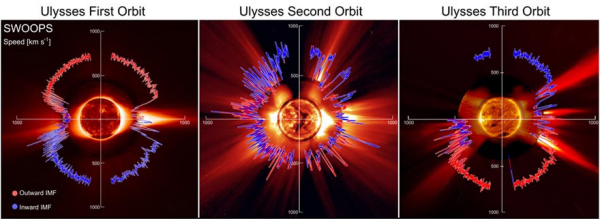Ulysses spacecraft data indicate solar wind at a 50-year low
23 September 2008
Data from the joint ESA/NASA Ulysses mission show that the Sun has reduced its output of solar wind to the lowest levels since accurate readings have become available. This current state of the Sun could reduce the natural shielding that envelops our Solar System.In the course of its more than 17 years of operations the Ulysses spacecraft has completed 3 polar orbits of the Sun, spanning more than one complete solar cycle. The resulting data set is a unique resource enabling researchers to study the three-dimensional structure of the solar wind and heliosphere.
A number of recent studies (see McComas et al., 2008, and references therein) have concluded that the solar wind observed in Ulysses' third orbit is about 25 percent less powerful than that measured during the spacecraft's first orbit. (Both of these orbits corresponded to periods of minimum solar activity.) While the wind speed is almost the same during both orbits, the density and pressure measured during the third orbit are significantly lower.
The Ulysses data covers high latitude regions of the Sun. In order to determine whether or not the apparent weakness in the solar wind was a phenomenon limited to these regions the study authors compared the Ulysses data with observations from the Advanced Composition Explorer (ACE) spacecraft (which observes in the ecliptic plane). Data from the two spacecraft correlated extremely well for comparable regions leading the authors to conclude that the observed weakness in the solar wind is a global phenomenon. Overall, the measurements indicate significant, long-term variations in solar wind output from the entire Sun.
The marked long-term trend to lower dynamic pressures implies that the heliosphere has been shrinking and as a consequence the distance to the heliopause is reduced. Since the heliopause acts as a shield for our solar system, warding off a significant portion of the cosmic rays outside the Galaxy, a reduction in size and strength could mean an increase in the number of Galactic cosmic rays which enter the inner part of the solar system.
Related publication
McComas, D.J., et al., "Weaker solar wind from the polar coronal holes and the whole Sun" Geophysical Research Letters, 35, L18103, DOI:10.1029/2008GL034896


